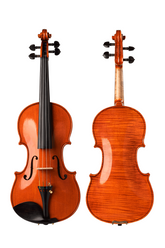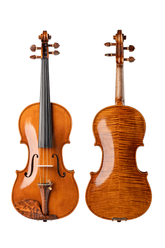Why the "Queen of Instruments" Holds the Premier Position
The violin, honored as the "Queen of Instruments," is not only essential for solo and chamber music performances but stands as the most important instrument in symphony orchestras, holding the premier position. On symphony orchestra concert programs, after the composer and conductor are listed, the concertmaster's (first chair violin) name appears next, while other musicians' names are typically omitted. This unique distinction fully demonstrates the violin's irreplaceable role in the orchestral world.

The Violin's Central Position in the Orchestra
The Concertmaster's Special Role
The concertmaster (first chair violinist) serves as the lead principal player of the symphony orchestra, holding a pivotal position with decisive influence. The concertmaster not only performs the most important solo passages but also coordinates the entire string section and, in some cases, represents the entire orchestra. Their artistic standards often reflect the quality of the entire ensemble.
Symphony Orchestra Composition
A symphony orchestra (also called a philharmonic orchestra) typically consists of the following instrumental groups:
First Group - String Section: Includes violins, violas, cellos, and double basses. Violins are the most numerous, usually comprising over one-third of the orchestra's total personnel. A standard configuration includes 30-40 violins, divided into first violin and second violin sections.
Second Group - Woodwind Section: Includes piccolo, flute, oboe, clarinet, English horn, bassoon, and saxophone.
Third Group - Brass Section: Includes trumpet, tuba, trombone, saxhorn, and French horn.
Fourth Group - Percussion Section: Includes timpani, triangle, cymbals, gong, tubular bells, and more.
Depending on the composer's requirements, piano, xylophone, harp, glockenspiel, or various ethnic instruments may also be added.
Three Major Roles of Violin in Orchestral Performance
1. Playing the Melody: The Orchestra's Soul
The violin is an instrument rich in character and personality. Its upper register is bright yet delicate, extremely charming, and possesses remarkable expressive power. Playing techniques are exceptionally flexible—it can produce a singing tone similar to the human voice, perform various melodies, fully express internal textural variations, and execute highly difficult passages.
As the largest section in the orchestra, violins form the rock-solid string foundation of the entire ensemble, becoming the orchestra's backbone. By performing the "main melody," they establish their core position within the orchestra.
Violin Melodies in Beethoven's Works
In the nine symphonies by the renowned composer Ludwig van Beethoven, the violin's dominant role is particularly prominent:
- Symphony No. 3 "Eroica": Nearly all main themes in different styles are performed by violins
- Symphony No. 5 "Fate": Violins deliver the earth-shaking fate motif
- Symphony No. 6 "Pastoral": Violins paint beautiful pastoral landscapes through melodic lines
Emotional Expression in Tchaikovsky's Works
Tchaikovsky's compositions also fully demonstrate the violin's expressive capabilities:
- Romeo and Juliet Fantasy Overture: Violins work closely with other orchestral instruments to vividly portray feuding families and the passionate love theme between Romeo and Juliet
- Symphony No. 6 "Pathétique": Violins perform tender yet melancholic themes, fully expressing the composer's personal suffering and struggle, passionate outcries, and fervent pursuit of life and love
These classic works prove that through performing main melodies, violins occupy a unique and indispensable position in the symphony orchestra.
2. Performing Cadenzas: Perfect Union of Technique and Emotion
What is a Cadenza?
A cadenza is a virtuosic solo passage, typically found in both vocal and instrumental music. Cadenzas originally emerged in Italian opera seria, where singers would improvise at the end of an aria. Later, cadenzas became common at the end of concerto movements.
Since Beethoven's Piano Concerto No. 5, cadenzas have typically been written out by composers. The modern concept of a cadenza refers to a passage featuring beautiful melody, rich colors, full emotion, and high technical difficulty. During a cadenza, the orchestra usually pauses while the soloist fully demonstrates their performing skills.
Classic Examples of Violin Cadenzas
The violin's important role in symphony orchestras is significantly demonstrated through performing cadenzas throughout compositions:
- Rimsky-Korsakov's "Scheherazade" (also known as "Arabian Nights"): The beautiful cadenza depicting Queen Scheherazade, filled with fairy-tale and fable-like charm, is performed by solo violin
- Richard Strauss's "Don Juan": The tone poem's cadenza expressing Don Juan's character and emotions is performed by violin
- Richard Strauss's "Don Quixote": The symphonic variations portraying Don Quixote's image also feature violin cadenzas
These cadenzas not only showcase violinists' superior skills but also use the violin's unique tone to vividly express characters' personalities and emotions.
3. Executing Advanced Techniques: Showcasing the Instrument's Ultimate Charm
The violin's important position in symphony orchestras is also demonstrated through performing passages requiring "advanced techniques." The violin has a wide range (spanning over four octaves) and extremely rich and flexible playing techniques.
Advanced Violin Performance Techniques
- Spiccato (Bouncing Bow): The bow bounces on the strings, creating light and agile sound effects
- Pizzicato: Plucking the strings with fingers, creating guitar-like tones
- Harmonics: Special fingering produces clear, transparent high notes like celestial sounds
- Vibrato: Rapidly alternating finger pressure makes notes shimmer with warmth
- Double Stops and Chords: Playing two or more notes simultaneously, enriching harmonic texture
- Rapid Scales and Arpeggios: Demonstrating virtuosity and adding brilliance to compositions
The use of these advanced techniques not only adds layers and tonal variety to symphonic works but also enables violins to handle every musical expression task—from lyrical to passionate, from delicate to majestic.
Violin Tone Characteristics and Expressive Power
The violin's designation as "Queen of Instruments" is inseparable from its unique tone and expressive capabilities:
Tonal Characteristics: The upper register is bright and clear, the middle register warm and full, and the lower register deep and powerful. The violin's tone can both resemble the singing quality of the human voice and imitate various sounds in nature.
Rich Expressiveness: Violins can perform both passionate, rapid passages and delicate, lyrical emotions; both technically demanding virtuosic sections and deeply moving beautiful melodies.
Strong Versatility: Through different playing techniques and dynamic variations, violins can create infinite tonal changes, making them composers' most beloved expressive tool.
The Violin's Legacy in Symphonic History
From the Baroque period to modern times, the violin has consistently been central to orchestral composition. Haydn, Mozart, Beethoven, Brahms, Tchaikovsky, and other master composers have all treated the violin as the symphony orchestra's soul instrument, creating countless classic works for it. This tradition continues today, with modern composers still regarding the violin as the most important expressive medium in symphony orchestras.
Why Choose Fiddlover Violin Shop for Your Orchestral Journey
At Fiddlover Violin Shop, we understand the violin's paramount importance in orchestral music. Whether you're an aspiring orchestral musician, a seasoned professional, or a music educator, we provide:
- Premium Quality Instruments: Carefully selected violins suitable for orchestral performance, from student models to professional concert instruments
- Expert Guidance: Our team understands the specific demands of orchestral playing and can help you find the perfect instrument
- Setup for Orchestra: Instruments professionally set up to deliver the projection, clarity, and tonal beauty required for ensemble playing
- Comprehensive Support: From bow selection to string recommendations, we provide everything you need for successful orchestral performance
Conclusion
The violin's position and role in symphony orchestras is comprehensive and multi-layered. Not only does it hold numerical superiority, but it also bears the core responsibility of performing main melodies, cadenzas, and advanced technical passages. The concertmaster, as the orchestra's lead principal player, holds importance second only to the conductor.
Indeed, the violin serves as the most direct bridge connecting the composer's creative vision with the audience's hearts. Because of the violin—this "Queen of Instruments"—symphony orchestras can fully present the magnificent musical tapestry conceived by composers and profoundly express humanity's richest and most delicate emotional world. This is the violin's unique, irreplaceable, and decisive position in the symphony orchestra.
Ready to begin your orchestral journey? Visit Fiddlover Violin Shop to discover instruments worthy of the symphony stage. Our passion is helping musicians find their perfect voice in the world's greatest orchestras.





